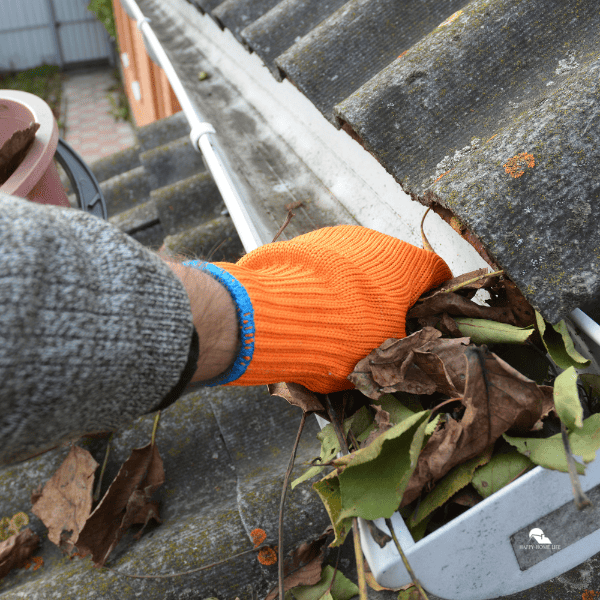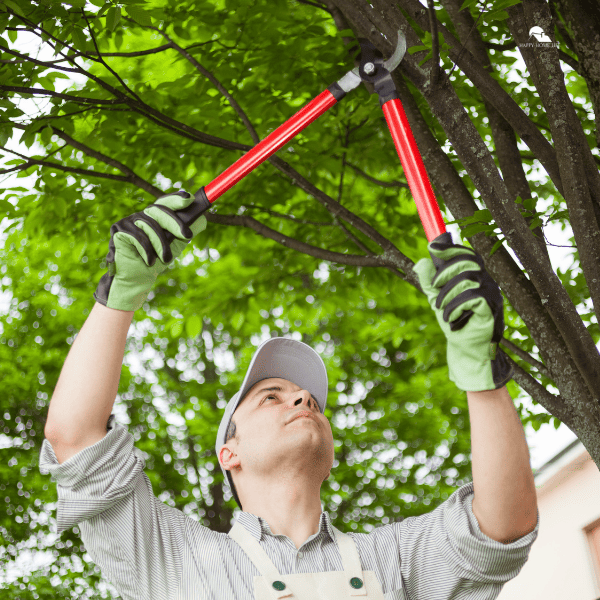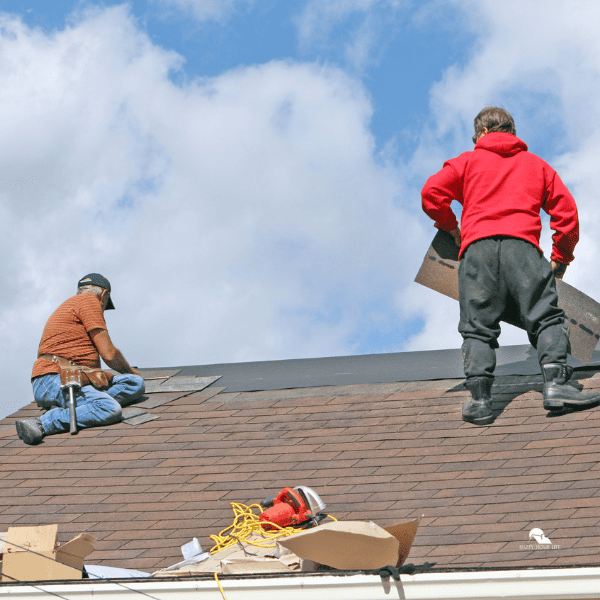As the warm embrace of summer approaches, it’s time to turn our attention to the exterior maintenance of our homes. During the longer days and milder summer weather, it’s the ideal time to tackle essential home maintenance tasks. From inspecting roofing to sprucing up landscaping, this article offers a comprehensive guide to preparing your home for the summer months.
This article equips you with essential home exterior maintenance tips. It helps protect your home, boost curb appeal, and ensure a pleasant summer for you and your family.

Clean and Inspect Gutters and Downspouts
As summer rolls in, clogged gutters and downspouts can significantly threaten your home. Leaves, debris, and nests can build up over time, blocking rainwater flow and risking foundation damage. Regular cleaning and inspection of your gutters and downspouts are crucial to prevent these issues and protect your home.
Here’s what you need to do:
- Schedule cleanings: Aim to clean your gutters at least once a year or twice if you have many trees around your roof.
- Inspect thoroughly: During cleaning, check for any signs of damage, loose connections, or rust.
- Clear debris: Remove any leaves, twigs, or other debris obstructing water flow.
- Flush the system: Once cleaned, use a hose to flush water through the gutters and downspouts, ensuring proper drainage.
As a general rule, cleaning your gutters once or twice a year is recommended by Angi. If many tall trees are near your property, you’ll need to clean them more often to prevent debris buildup. Professional gutter cleaning services are readily available if DIY cleaning isn’t your forte. The typical cost for this service is about $159, but it varies based on factors like damage, complexity, and property size.
Check and Repair Roof Shingles
Summer’s heat and intense sun can expose weaknesses in your roof’s defenses. To prevent potential leaks and safeguard your home’s interior, take the time to inspect and repair any damaged roof shingles.
Here’s what to look for:
- Missing or cracked shingles: These create openings for water to seep through during heavy rain showers.
- Curled or warped shingles: This indicates potential underlying problems like moisture damage or improper ventilation.
- Granule loss: If shingles appear excessively worn and lack granules, their protective layer is compromised.
Trim Trees and Bushes
As summer unfolds, overgrown trees and bushes can not only obstruct your view and block sunlight but also pose potential safety hazards. Here’s why trimming is crucial:
- Aesthetics: Neatly trimmed trees and bushes enhance your home’s curb appeal and create a more polished appearance.
- Safety: Overgrown branches near power lines pose a fire risk during storms with strong winds and lightning. Trimming also removes dead branches that could fall and cause damage or injury.
- Sunlight and ventilation: Dense foliage can block sunlight from entering your home, making it feel stuffy and dark. Adequate trimming promotes improved air circulation and allows natural light to penetrate more effectively.
According to Shondaland, late winter through early spring is optimal for trimming. Depending on your location, this timeframe typically ranges from late January to mid-April. Watch for signs like thawing ground, the end of nighttime frosts, and the emergence of new leaves.

Clean and Seal Exterior Woodwork
Summer’s sunshine and warm weather often bring out outdoor living enjoyment. However, these elements can also take a toll on your home’s exterior woodwork, including decks, patios, and fences. Regular cleaning and sealing are essential to maintain their beauty and functionality.
Here’s how to keep your exterior woodwork looking its best:
- Cleaning: Start by cleaning the wood thoroughly with a gentle detergent solution and a soft brush to eliminate accumulated dirt, grime, and mildew.
- Drying: Allow the wood to dry completely before proceeding further. Moisture trapped beneath the sealant can lead to peeling and other issues.
- Inspecting: Once dry, inspect the wood for any signs of damage like cracks, warping, or loose boards. Address any necessary repairs before applying sealant.
- Sealing: Choose a high-quality exterior wood sealant appropriate for the specific type of wood you’re working with. Apply the sealant according to the manufacturer’s instructions, ensuring even coverage.
Inspect and Maintain Barge Boards
As the summer sun beats down, don’t neglect your roofline. Over time, harsh weather can take a toll on your barge boards, those decorative and functional elements at the edges of your gables. The barge board helps protect the exposed roof rafters and prevent water infiltration. During summer maintenance, inspect barge boards for damage like cracks, rot, or loose nails. Early detection and repair are crucial.
Minor issues like loose nails or small cracks can often be addressed with basic DIY skills and readily available materials. However, consulting a professional roofer is highly recommended for more extensive damage like severe rot or warping. Prompt repairs not only maintain the aesthetic appeal of your home’s exterior. More importantly, they safeguard the structural integrity of your roof and prevent potential water damage during summer downpours.
Belco Forest Products recommends replacing older, damaged barge boards with modern options like fiber cement or OSB for improved weather resistance and long-lasting performance. These materials offer superior durability, require less frequent maintenance, and can even enhance the overall aesthetics of your home’s exterior.

Check and Service Outdoor HVAC Units
As summer temperatures soar, your air conditioning system is about to work overtime to keep your home cool and comfortable. Regular preventive maintenance is crucial to keep your HVAC system running smoothly throughout the season, helping you avoid unexpected breakdowns and expenses.
Here’s how you can prepare your outdoor unit for the summer:
- Clear the area: Begin by clearing away any leaves, debris, or overgrown vegetation surrounding the unit to ensure adequate airflow and prevent overheating.
- Clean the unit: Gently remove dust and grime from the exterior using a soft brush or a vacuum cleaner with a hose attachment. Avoid using harsh chemicals or water directly on the unit.
- Check the fins: The condenser coils, resembling thin metal fins, are responsible for releasing heat. If they are bent or clogged with dirt, the unit’s efficiency can suffer. Carefully straighten any bent fins with a fin comb and brush away any debris lodged between them.
- Change the air filter: A clean air filter is vital for optimal performance and air quality. Replace the filter according to the manufacturer’s recommendations, typically once a month during peak cooling seasons.
- Consider professional servicing: Remember, while the above steps can be done by most homeowners, scheduling a pre-season inspection and tune-up by a qualified technician is highly recommended. This proactive approach can identify potential issues early on, ensuring your air conditioning system operates at its peak efficiency throughout the hot summer months.
Regular maintenance not only prevents costly repairs down the line but can also save you money on your energy bills. HomeGuide says HVAC repairs can range from $150 to $450 on average. Routine maintenance typically costs between $10 to $25 per month or $150 to $300 per year. These maintenance plans often include twice-yearly tune-ups, cleaning, and adjustments for both your heating and cooling systems.
Additionally, you might benefit from priority scheduling and service repair discounts offered by most HVAC maintenance contracts and service plans.

Inspect and Repair Exterior Paint and Caulking
To maintain a beautiful and weatherproof exterior, take some time to inspect these areas for any signs of damage.
Look for cracks, peeling paint, or gaps around windows, doors, and other openings. These can indicate failing caulking, allowing moisture to seep in and leading to further problems. If you find any issues, address them promptly. For minor cracks or peeling paint, you can often handle touch-ups yourself. However, for extensive damage or areas requiring re-caulking, consulting a professional painter or contractor is recommended.
In conclusion, investing time and effort into these essential home exterior maintenance tasks ensures that your home remains well-prepared for the summer season. By following these tips, you can enhance the curb appeal, functionality, and longevity of your property. It creates a comfortable and enjoyable environment for you and your family to relax and unwind during the warmer months.






